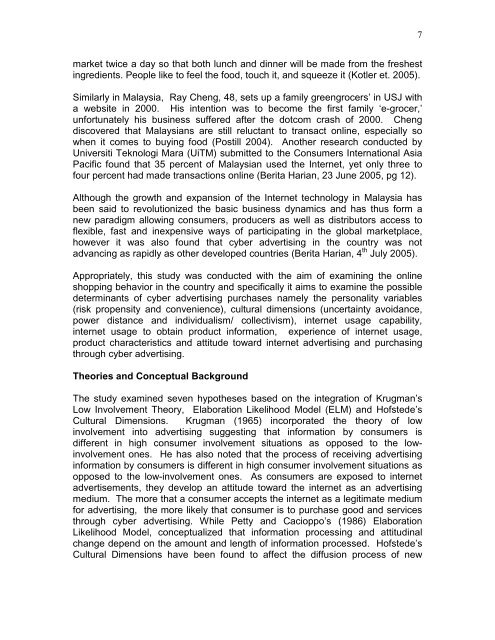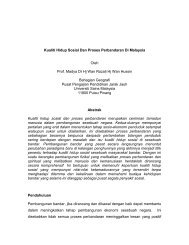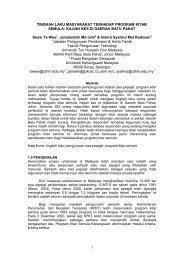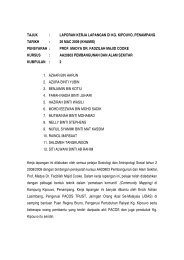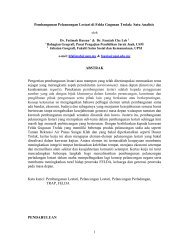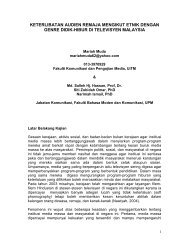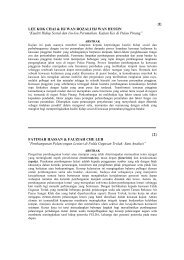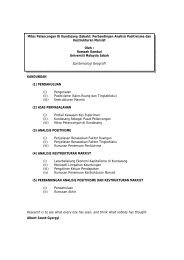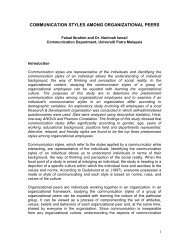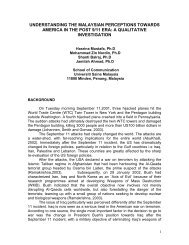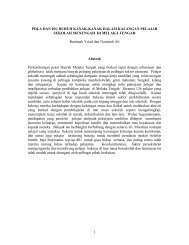FACTORS AFFECTING ONLINE PURCHASING BEHAVIOR
FACTORS AFFECTING ONLINE PURCHASING BEHAVIOR
FACTORS AFFECTING ONLINE PURCHASING BEHAVIOR
Create successful ePaper yourself
Turn your PDF publications into a flip-book with our unique Google optimized e-Paper software.
7market twice a day so that both lunch and dinner will be made from the freshestingredients. People like to feel the food, touch it, and squeeze it (Kotler et. 2005).Similarly in Malaysia, Ray Cheng, 48, sets up a family greengrocers’ in USJ witha website in 2000. His intention was to become the first family ‘e-grocer,’unfortunately his business suffered after the dotcom crash of 2000. Chengdiscovered that Malaysians are still reluctant to transact online, especially sowhen it comes to buying food (Postill 2004). Another research conducted byUniversiti Teknologi Mara (UiTM) submitted to the Consumers International AsiaPacific found that 35 percent of Malaysian used the Internet, yet only three tofour percent had made transactions online (Berita Harian, 23 June 2005, pg 12).Although the growth and expansion of the Internet technology in Malaysia hasbeen said to revolutionized the basic business dynamics and has thus form anew paradigm allowing consumers, producers as well as distributors access toflexible, fast and inexpensive ways of participating in the global marketplace,however it was also found that cyber advertising in the country was notadvancing as rapidly as other developed countries (Berita Harian, 4 th July 2005).Appropriately, this study was conducted with the aim of examining the onlineshopping behavior in the country and specifically it aims to examine the possibledeterminants of cyber advertising purchases namely the personality variables(risk propensity and convenience), cultural dimensions (uncertainty avoidance,power distance and individualism/ collectivism), internet usage capability,internet usage to obtain product information, experience of internet usage,product characteristics and attitude toward internet advertising and purchasingthrough cyber advertising.Theories and Conceptual BackgroundThe study examined seven hypotheses based on the integration of Krugman’sLow Involvement Theory, Elaboration Likelihood Model (ELM) and Hofstede’sCultural Dimensions. Krugman (1965) incorporated the theory of lowinvolvement into advertising suggesting that information by consumers isdifferent in high consumer involvement situations as opposed to the lowinvolvementones. He has also noted that the process of receiving advertisinginformation by consumers is different in high consumer involvement situations asopposed to the low-involvement ones. As consumers are exposed to internetadvertisements, they develop an attitude toward the internet as an advertisingmedium. The more that a consumer accepts the internet as a legitimate mediumfor advertising, the more likely that consumer is to purchase good and servicesthrough cyber advertising. While Petty and Cacioppo’s (1986) ElaborationLikelihood Model, conceptualized that information processing and attitudinalchange depend on the amount and length of information processed. Hofstede’sCultural Dimensions have been found to affect the diffusion process of new


